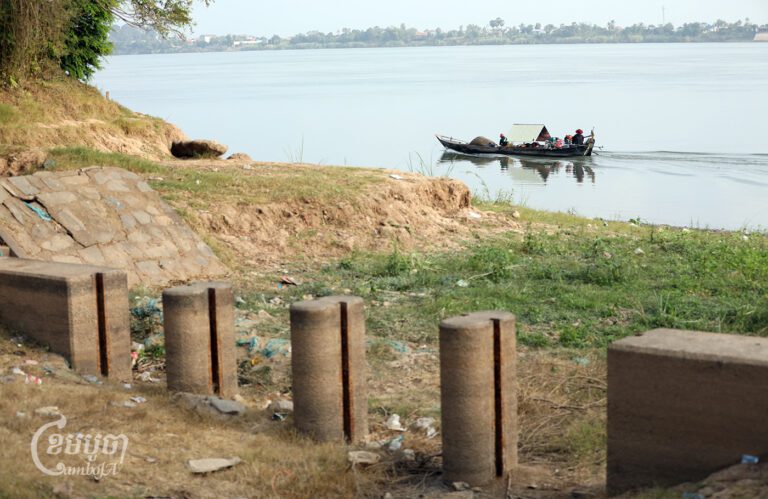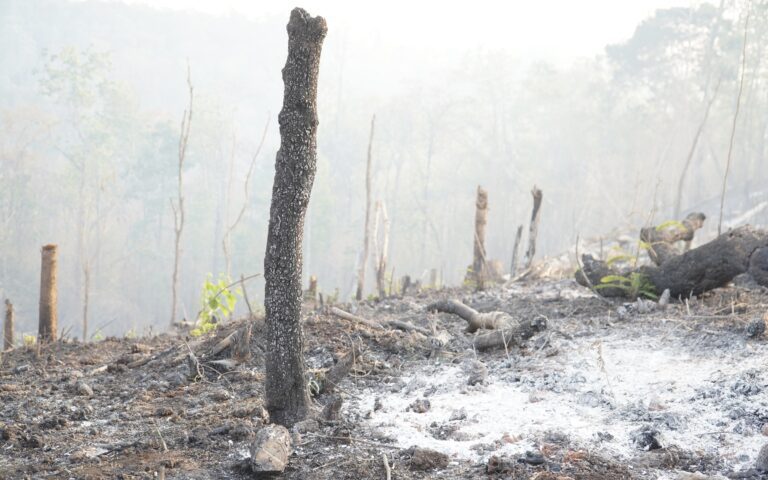Srae Chis commune, Kratie province — The scorched remains of an Environment Ministry station still lay strewn about after more than 300 farmers burned it down two weeks ago. Even the outhouse was reduced to rubble in the culmination of a multi-year conflict between local communities and ministry officials.
“If they come back, we will burn it down again. If the village chief lets them come back, we will burn down his house too,” said one farmer from Srae Chis village, his eyes watering with rage.
Rumors that the boundaries of nearby Sor Sor Sdom Sat Tao protected area would expand prompted the torching of the Environment Ministry station, according to people who had participated. But anger with ministry officials had been simmering for years in the commune’s primarily indigenous Kraol community. Ever since ministry officials arrived in 2021, they had been clearing people off land under cultivation for generations, more than 10 residents told CamboJA.
“People just went from house to house, they asked ‘Where are you going,’ and they said, ‘Going to protest at the Environment Ministry!” said Kin Parong, a resident of Srae Chis village. “Others called ‘I will, come too!’”


One week later, Environment Minister Say Sam Al confirmed in a Facebook post that the protected area had expanded from 839 hectares to 5,327 hectares — six times its previous size — in order to connect with the Phnom Prich Wildlife Sanctuary across the border in Mondulkiri province.
The sub-decree follows vast extensions of other protected areas throughout the country issued in July and totalling more than 750,000 additional hectares, largely through reclassifying land established as biodiversity corridors in 2017, including the area around Sor Sor Sdom Sat Tao.
Yet these areas engulfed existing community agricultural land, which became illegal for residents to farm under the biodiversity corridor and protected area designations. Human rights groups and environmental activists are concerned that the increasing enforcement of expanded protected area boundaries will fuel land conflicts with the Environment Ministry.
“If that expansion of 5,000 hectares belongs to them [the Environment Ministry], it means all of our land overlaps theirs. We trust them with ensuring our rights but instead they treat us like the Khmer Rouge,” said Kraol villager Touch Chan. “I think if they fostered good faith, no villagers would criticize them. There is no smoke without fire.”

Environment Ministry spokesperson Neth Pheaktra did not respond to repeated requests for comment.
Human rights NGO Adhoc’s spokesperson Seong Senkaruna said last week that while he had not heard about the expansion of 5,327 hectares in Kratie province, he presumed that the government had conducted an impact assessment investigation.
“We already know that the community forages forest products as such, and thus I think the government must have conducted an initial environmental impact assessment to understand the indigenous people’s livelihoods,” Senkaruna told CamboJA.
Sor Sor Sdom Sat Tao was formed as a vaguely defined multiple use protected area by sub-decree 201 in November 2017, encompassing a tall lion statue built during the 1950s to commemorate a military victory.

Kraol community leader Mer Da said villagers did not hear about the sub-decree until 2018, and they did not know how it would impact their agricultural practices or daily life until ministry officials arrived in 2021.
“They never showed us a map, they just took land ambiguously,” said Da, explaining why there was so much confusion and animosity from local communities.
People were moved off their fields in 2021 by the armed officials with no offer of compensation, according to residents of Srae Chis village and neighboring Rovieng village. That was the same year the station was built.
Some said officials began threatening them with arrest or confiscated their tools when cutting down trees for fences. Villagers were prevented from gathering non-timber forest products or from continuing their rotational farming on fields that were fallow when the ministry first arrived, others said.
After community members cut wood to build fences to mark the new boundaries and keep their animals contained, ministry officials repeatedly removed the fencing, five of the villagers told CamboJA.
“They pull out our fence posts and burn them. We put fence posts in, then they pull them up, we put them in, they pull them up,” said one villager, who like others interviewed by CamboJA did not want to be named for fear of her safety.
She said her family had lost multiple hectares of productive farming land since the ministry arrived in 2021.

Contacted by phone multiple times last week, Srae Chis Commune Chief Pich Touch told CamboJA that he was unable to provide a comment at the moment because he was busy with meetings related to the incident.
“Before the environmental officials came, people could live peacefully, but after everything was more difficult,” said Srae Chis villager Pharong, who said ministry officials confiscated his chainsaw in early August.
“I am worried they will come back and arrest people,” he said. “But people in the community won’t let them come back.”
Kratie provincial Environment Department Director Chhay Duong Savuth said the arsonists must be held accountable.
“The new office must be rebuilt at the same place,” he said. “If they do not agree, it means they want to separate themselves, because our country has laws.”
O’Krieng Senchey District Governor Chhear Phally stated that there is currently no solution to this conflict, and that officials at the district level must first coordinate with the Environmental Ministry, commune and village to identify the fundamental causes.
“The majority of them being indigenous people, they could misinterpret [the situation with the protected area],” Phally said. “Therefore, the district officials will go out and educate them.” Besides clearing fields, Kraol community members expressed concerns about how the ministry treats their community forest, called Tropeang Kondeung, within Sor Sor Sdom Sat Tao. A few even accused the officials of accepting bribes from illegal loggers.
“They are environmental officials coming to protect the forest. But they prevent us from foraging while others transport tons of timber across here,” said Kraol villager Chan.
Community members have been told by ministry officials that they cannot cut down small trees for fences or patrol their community forests, he added, but outsiders pass through the village with freshly cut hardwood.
“What does the Environment Ministry protect?” one villager said. “They did not protect, just came to take money and repress people.”















